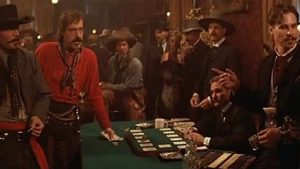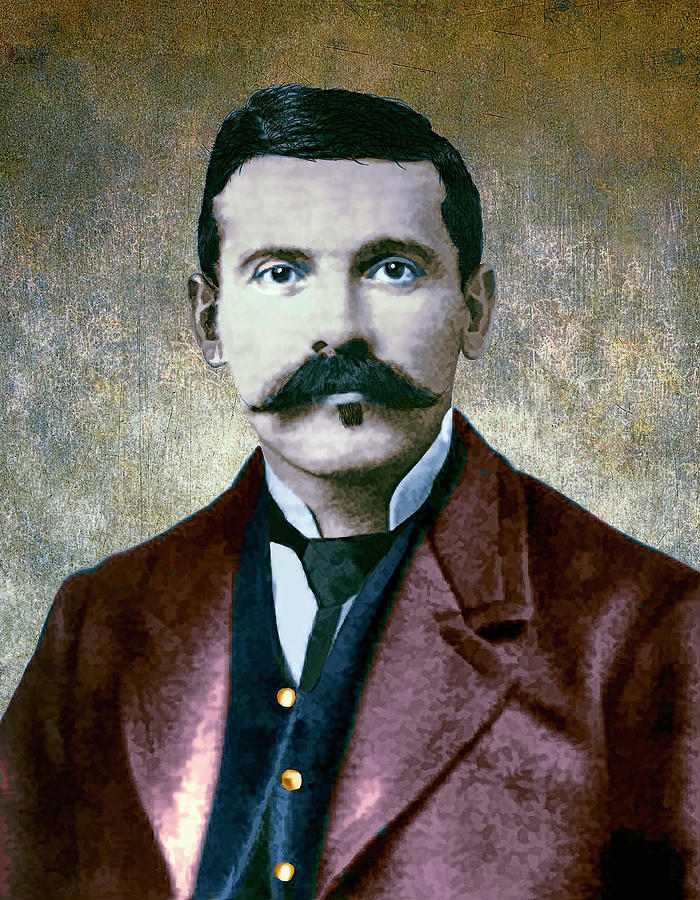Doc Holliday Poker Scene
— Doc Holliday, 1886. Insightful Doc Holliday Quotes #13. “There is no normal life, there’s just life. Get on with it.” — Doc Holliday, Tombstone #14. “Credat Judaeus Apella, non ego.” — Doc Holliday, Tombstone #15. “I said poker’s an honest trade. Only suckers buck the tiger. The odds are all with the house.” — Doc. Doc Holliday: they both start moving in circles slowly into position for a showdown, staring at each other without blinking Say when. Doc Holliday: they both draw but Holliday is a tad quicker and shoots Ringo in the head and Ringo struggles to stay standing and finally falls Poor soul. John Henry 'Doc' Holliday (August 14, 1851 – November 8, 1887) was an American gambler, gunfighter, and dentist.A close friend and associate of lawman Wyatt Earp, Holliday is best known for his role in the events leading up to and following the Gunfight at the O.K.
Dying in bed at the age of 36, Doc Holliday is said to have taken a final drink of whiskey and looked down at his feet and said “This is funny.” After fifteen years of moving from cow towns to mining towns gaining a mostly unfounded reputation as a gunfighter and desperado, Doc Holliday died. Perhaps he found it strange to meet a peaceful end rather than die in a gunfight. He certainly had seen a fair share of action over the years and had been shot and beaten on several occasions. One fight in Texas left Holliday in such a bad state that the local newspaper reported that he’d died afterwards – this of course was not true.
When did he die?
Doc Holliday died on November 8, 1887 around ten o’clock in the morning
Where?
The Hotel Glenwood in Glenwood Springs, Colorado.

Was Wyatt there like in the film Tombstone?

No. Wyatt heard of Doc’s death shortly after he had died. He was close by in Aspen at the time and it’s thought that he may have visited Doc before his death, although no accounts exist to verify this. Josie Earp told a story about sitting beside Doc’s deathbed but it’s thought that she may have confused this with another occasion. Josie Earp did also give an account of Doc and Wyatt’s last meeting in the lobby of a Denver hotel. Both men were quite upset and Josie said that Wyatt cried afterwards.
Tombstone Doc Holliday Poker Scene
After Doc Holliday died, Doctor Crook sent Wyatt a photograph of Doc that had been taken in Glenwood Springs before he had become bedridden. There’s also a story that Doc’s gun was also sent to Wyatt although again not a lot of evidence to prove whether or not it’s true.
Who was with him?
Doctor Crook looked after Doc during the thirty-three days that he was bedridden. Doctor Crook practiced in Leadville, Co prior to moving to Glenwood Springs. Both Doc Holliday and Doctor Crook knew of one another in Leadville and it’s quite possible that Holliday had received medical care from Doctor Crook in Leadville.
In the 1970s, Art Kendricks, a prominent Glenwood Citizen and ex-mayor of Glenwood Springs would recall his early days working as a busboy in the Hotel Glenwood. He told Mr. A. E. Axtell, City Manager of Glenwood Springs that on numerous occasions he would be called up to Doc’s room to bring a bottle of liquor and was tipped ten cents each time.
According to Karen Holliday Tanner’s book Doc Holliday – A Family Portrait, Big Nose Kate was also with Doc when he died and made the funeral arrangements.
Final Words

Doc is said to have had a final drink of whiskey and said,”This is funny.”
Was there a Sanatorium in Glenwood Springs at the time?

No not in 1887. That would come later when The Saint Joseph’s Sanatorium was opened by The Sisters of Charity Leavenworth in 1898. The Sanatorium was part of the Yampah Hotel.
Personal Belongings
A diamond stickpin with the diamond removed, a small knife, a straight razor and some toiletries were among the possessions that Doc left after he died. These were forwarded on to Doc’s cousin and correspondent of fifteen years Martha Anne Holliday.
Funeral
Rev. W.S. Rudolph delivered the funeral address. On November 9, 1887 The Aspen Daily Times reported “Glenwood Springs, Colo., November 8 – Doc Holliday died here this morning at the Hotel Glenwood and was buried this afternoon and was followed to the cemetery by a large number of kindred spirits.”
Gravesite
There are all kinds of stories about this. The official record is that Doc’s remains were moved from the old cemetery and placed in the newer Linwood Cemetery near where the current memorial stone stands. Others say that the ground was too icy to bury him on top of the hill and that he’s still buried where the old cemetery was which is probably under someone’s house. This is quite unlikely as all the bodies were moved.
In a letter addressed to Susan McKey Thomas in 1973 Art Kendricks is again called upon to recollect Doc Holliday’s burial. He stated that Doc was buried on Palmer Avenue and Twelfth Street, just below the Linwood Cemetery. He would then account that Doc’s body was moved up to Linwood Cemetery at a later date and that he had marked the place with a small wooden cross. The American Legion Post donated a headstone to replace the wooden cross. This is where the current headstone sits.
It’s interesting to note that the grave next to Doc’s is Arthur Seller’s who died of typhoid in The Hotel Glenwood on September 22, 1887 just a few weeks before Doc. His room was across the hall from Doc’s. I think there’s a good chance that Doc is buried close to the marker as it would make logical sense to lay out the new cemetery with the most recently deceased next to one another. However, since the records for the cemetery are missing from the times, I can’t verify this one way or another.
Another suggestion has been made that Doc’s body was shipped back to Georgia and buried in Griffin, GA. Two unmarked gravestones have been found in Oak Hill cemetery. It’s claimed that one of the gravestones is for Doc’s father Major Henry Burroughs Holliday and the other for Doc Holliday himself. Again, there is currently no easy way to prove this one way or another.
Doc Holliday Poker Scene
Doc’s 100th Anniversary
In 1987, on the 100th anniversary of Doc Holliday’s death, Glenwood Springs celebrated with a wake and a funeral procession with disturbingly enough a Doc Holliday impersonator in a casket. There was also a huge poker party where local dentists served as dealers.
Visiting Doc’s Grave
Whether or not Doc is buried in Linwood Cemetery doesn’t bother visitors to Doc’s memorial. They endure the steep walk to leave flowers, playing cards, empty bottles of whiskey and even toothpaste at the site.
John Henry 'Doc' Holliday. Even people who don't like westerns seem to like Tombstone, and even people who don't like Val Kilmer (which is hard to believe) seem to like the former Batman's portrayal of Doc Holliday.
Mention Wyatt Earp and you're going to run into Doc, and vice versa. They really were friends, though an odd match. Holliday came from Georgia money, was well-educated -– he earned exceptional grades on his way to graduating from dental school, so yes, he really was a dentist, and apparently quite a good one –- and Earp was a farm boy who had knocked around the 19th century American West far more interested in trying to make a buck than reading a book. Wyatt claimed they bonded when Doc saved his life in Kansas. By nearly everyone's account, the alcoholic, surly, and dying Doc was not much fun to be around. But he counted Wyatt as one of his few friends, and Wyatt counted on Doc.

Biography tells us that John Henry was born in 1851 in Georgia. He had something of a charmed life; as an infant he underwent a cutting-edge, albeit harrowing, procedure to correct his cleft palate. The baby survived, at least in part because of his mother's constant attention. That attention no doubt included bouts of tuberculosis, which killed Holliday's mother when he was just 15. It also took his adopted brother.
Tuberculosis was also known as consumption, and for good reason. If by some quirk of fate you get a chance to pick your own fatal disease, don't pick TB in the 19th century. You would suffer unintentional weight loss, coughing ... coughing up blood. The lung tissue would slowly tear apart; much worse than a bad cold, and in those days, always fatal.
It's a slow and exceedingly painful way to go. Doc was diagnosed right around the time he graduated from dental school. The common wisdom in those days was that a warmer, drier climate would forestall the inevitable. Doc went west.
It's a good bet Doc didn't examine patients while wearing gloves
A blood-coughing dentist isn't likely to attract a lot of patients, even in the days when dentists were consulted because of excessive pain, and not just for a cleaning and a free toothbrush. Doc quickly found that he could earn more money gambling than he could extracting or even drilling teeth.
Some people refer to him as the 'deadly dentist,' but the facts indicate that as a gunslinger Doc killed one, maybe three, people in the course of his life, and one of those with Wyatt in the infamous Tombstone gunfight. There was also the poker game when he carved up one of his opponents with a knife (the opponent survived) and other acts of violence, in self-defense or not.
But nothing — not climate or clean living was going to stop John Henry Holliday's very slow and painful slide into the grave. After wandering the American West in search of relief and better poker games, Doc checked into a hotel in Glenwood Springs, Colorado. The nearby sulfur springs were thought to be curative, but actually probably hastened the damage to Doc's already compromised lungs.
He rose occasionally from his sick bed to tend bar, when he could summon the energy, which wasn't often. Gambling was out of the question; he was too sick to concentrate, and alcohol dependency, in part to combat his considerable pain, kept him in a mental fog. He spent his last two weeks impoverished and confined to bed in varying states of consciousness -– meningitis being one of the side effects of untreated tuberculosis. Wyatt did not bring him flowers, or anything else, for that matter.
Doc died the morning of November 8, 1887, at the ripe old age of 36, six years after the Tombstone shootout. If you'd like to visit the grave, good luck; no one is quite sure where he's buried.